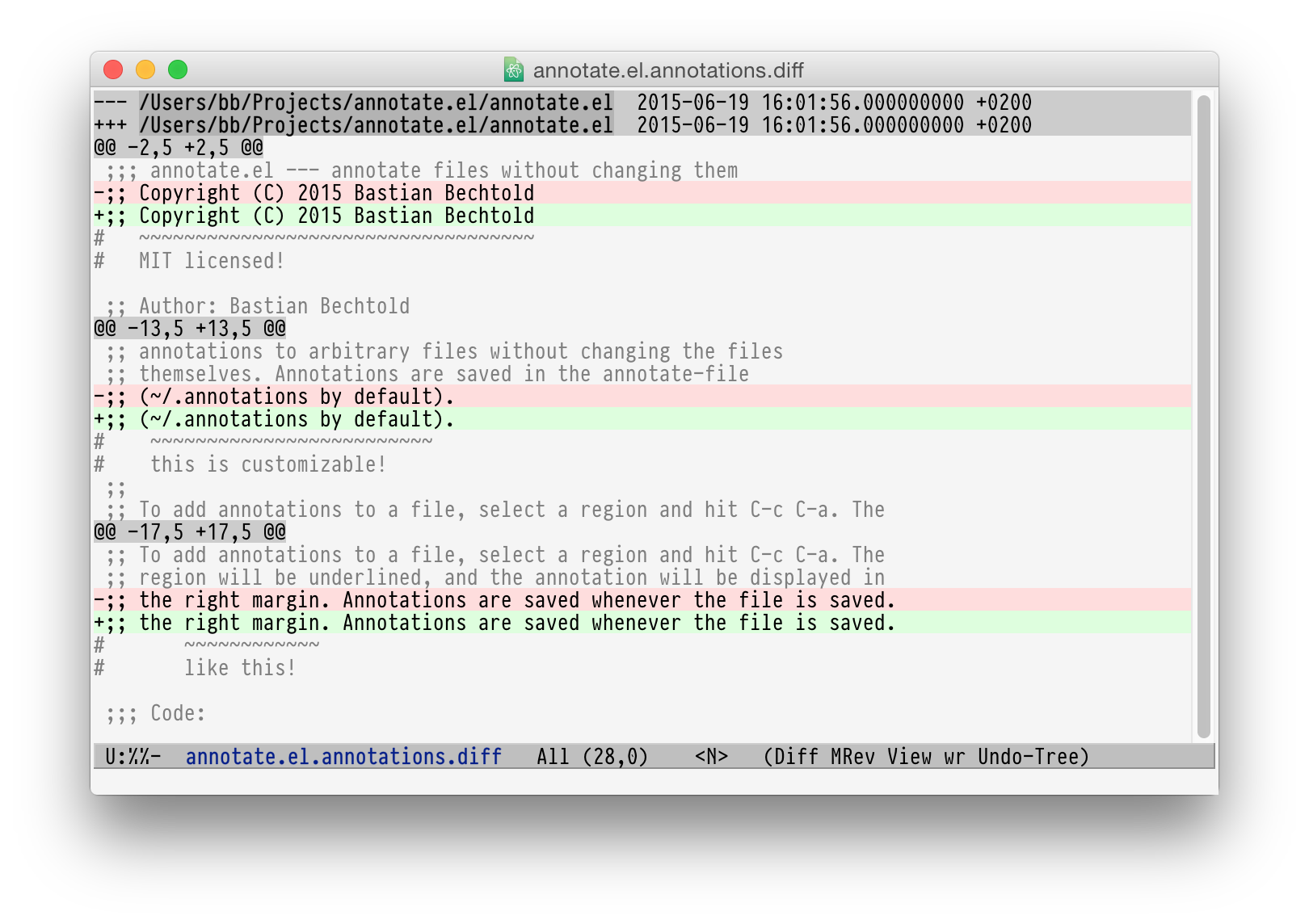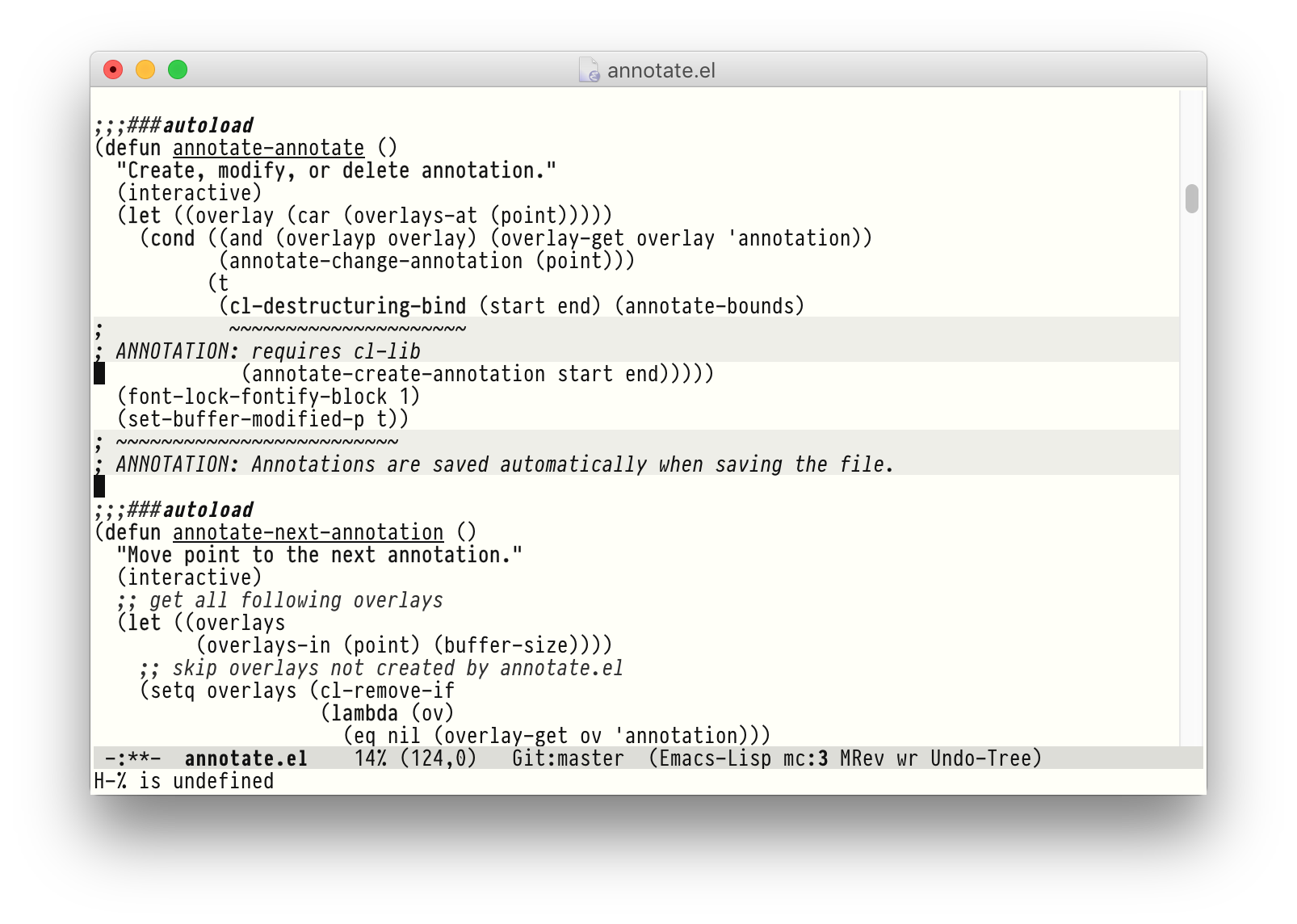This package provides a minor mode annotate-mode, which can add annotations to arbitrary files without changing the files themselves. This is very useful for code reviews. When annotate-mode is active, C-c C-a will create, edit, or delete annotations.

With an active region, C-c C-a creates a new annotation for that region. With no active region, C-c C-a will create an annotation for the word under point. If point is on an annotated region, C-c C-a will edit that annotation instead of creating a new one. Typing C-c C-d or clearing the annotation deletes them.
Use C-c ] to jump to the next annotation and C-c [ to jump to the previous annotation.
The current database for annotations is contained in the file
indicated by the variable annotate-file (~/.emacs.d/annotations by
default) but each user can change this value in a dynamic way using
the command annotate-switch-db. This command will take care to
refresh/redraw all annotations in the buffers that uses
annotate-mode.
The database holds the hash of each annotated file so it can print a warning if the file has been modified outside Emacs (for example).
Warning can be suppressed setting the variable
annotate-warn-if-hash-mismatch to nil.
Please note that switching database, in this context, means rebinding
the aforementioned variable (annotate-file). This means than no
more than a single database can be active for each Emacs session.
If an empty annotation database (in memory) is saved the database
file is deleted instead, if annotate-database-confirm-deletion is
non nil (the default) a confirmation action is asked to the user
before actually remove the file from the file system.
annotate-fileannotate-warn-if-hash-mismatchannotate-database-confirm-deletion
To use multiple database in the same Emacs session annotate-file should be made buffer-local,
see:
this thread and, in particular this message.
Finally, if the customizable variable annotate-file-buffer-local is non-nil (default nil), for each annotated file an annotation database is saved under the same directory that contains the annotated file.
The name of the annotation database is built concatenating the name of the annotated file without the optional extension and the string value bound to the customizable variable annotate-buffer-local-database-extension (default: notes), example follows:
| annotated file | annotations file |
|---|---|
| /home/user/foo.c | /home/user/foo.notes |
Important note: if /home/user/foo.notes exists, will be overwritten.
annotate-file-buffer-localannotate-buffer-local-database-extension
Users of no-littering can take advantage of its packages generated files management.
Creates a new annotation for that region.
With no active region, C-c C-a will create an annotation for the word under point. If point is on an annotated region, C-c C-a will edit that annotation instead of creating a new one. Clearing the annotation deletes them.
If annotate-annotation-confirm-deletion is non nil (the default is nil) a confirmation action is asked, using y-or-n-p, to the user before actually remove the annotation.
If point is the newline character and the customizable variable annotate-endline-annotate-whole-line is not nil (default is non nil) the whole line is annotated (or the next if the line is empty).
If the line contains a single annotation that cover all the line, annotating the newline will ask to edit the annotation. If annotate-endline-annotate-whole-line is nil annotating a newline will signal an error.
With a numeric prefix the annotations will be displayed with the faces indicated in annotate-highlight-faces and annotate-annotation-text-faces, respectively. The numeric prefix is used as index in the lists bound to the aforementioned variables.
The first theme can be addressed by the prefix 1, the second by the prefix 2 and so on.
annotate-annotation-column;annotate-annotation-confirm-deletion;annotate-annotation-max-size-not-place-new-line;annotate-annotation-position-policy;annotate-endline-annotate-whole-line;annotate-highlight-faces;annotate-annotation-text-faces.
Delete an annotation under point, if such annotation exists.
If annotate-annotation-confirm-deletion is non nil (the default is nil) a confirmation action is asked, using y-or-n-p, to the user before actually remove the annotation.
annotate-annotation-confirm-deletion.
Jump to the next annotation.
Jump to the previous annotation.
Show summary window.
A window with a list of annotated files together with their annotations is shown. If annotate-summary-ask-query is non nil (default is t) then a prompt is shown where the user can insert a query to filter the annotation database, see “Query Language”
below.
The summary window allow editing and removing of annotation using the provided buttons.
The annotation text can be pressed to and will open the annotated file, placing the cursor at the point where the corresponding annotated text appears.
annotate-summary-ask-query.
Change the color of the annotation below point (both higlight and annotation text colors are changed).
These changes are kept after the buffer is killed.
Change the policy positioning the annotation below point, a message with the new policy is printed.
These changes are kept after the buffer is killed.
Annotations can be exported annotate-export-annotations as commented unified diffs, like this:
Alternatively, they can be integrated annotate-integrate-annotations as comments into the current buffer, like this:
annotate-integrate-markerannotate-diff-export-optionsannotate-integrate-highlightannotate-fallback-comment
An annotation database file can be imported using the command annotate-import-annotations.
When importing, overlapping annotations will be merged in a single annotation with the new annotated text that maximizes the portion of text annotated, e.g.
The quick brown fox ← text
^^^^^^^^ ← first annotation
******** ← second annotation
+++++++++++++ ← merged annotation
The text of the merged annotation is the concatenated text of the two annotations.
Note that importing a database will modify permanently the file bound to the variable annotate-file. If unsure of the results, backup that file before importing.
annotate-database-confirm-import.
For typographically difficult scenarios (or just because you prefer it), such as variable-width fonts or overlay-heavy modes, the default visualization system that renders the annotation into the buffer could not properly works.
In this case the users can switch to a “pop-up” style annotation setting to a non-nil value the variable annotate-use-echo-area.
When such variable’s value is not null, moving the mouse pointer over the annotated text will temporary show the annotation.
The actual visuals of this “pop-up” can be different depending of your system’s setup (see this pull request for a couple of examples.
Moreover if annotate-use-echo-area and annotate-print-annotation-under-cursor value both non null, placing the cursor over an annotated text region will print the annotation’s text in the minibuffer prefixed by the value of customizable variable annotate-print-annotation-under-cursor-prefix, after a delay (in seconds) defined by the variable annotate-print-annotation-under-cursor-delay.
Another alternative way to show annotations is provided by the command: annotate-summary-of-file-from-current-pos.
Calling this command will show a summary window that prints all the annotations related to annotated text that appears (in the active buffer) beyond the current cursor position.
annotate-use-echo-areaannotate-print-annotation-under-cursorannotate-print-annotation-under-cursor-prefixannotate-print-annotation-under-cursor-delayannotate-summary-of-file-from-current-pos.
This command will ask the user for a new annotation database files, load it and refresh all the annotations contained in each buffer where annotate minor mode is active.
See the docstring for more information and this thread for a possible workflow where this command could be useful.
Shows or hides annotation’s text under cursor.
Shows or hides the annotation’s text in the whole buffer.
Please check M-x customize-group RET annotate as there is extensive documentation for each customizable variable.
- Annotations in org-mode source blocks will be underlined, but the annotations don’t show up. This is likely a fundamental incompatibility with the way source blocks are highlighted and the way annotations are displayed.
- Because of a limitation in the Emacs display routines
scroll-down-linecould get stuck on a annotated line. So no fix can be provided by the authors ofannotate.el, a possible
workaround is to call the command with a numeric prefix equals to one plus the number of annotation text lines below the annotated text.
For example:
foo bar baz
annotation
needs a prefix of 2: C-u 2 M-x scroll-down-line
But note that:
foo bar baz annotation
Needs no prefix.
- Deleting the first character of an annotated text will remove the annotation (this turned out to be useful, though).
To report bugs please, point your browser to the issue tracker.
The summary window can shows results filtered by criteria specified with a very simple query language, the basis syntax for that language is shown below:
[file-mask] [(and | or) [not] regex-note [(and | or) [not] regexp-note ...]]
where:
- file-mask
- is a regular expression that should match the path of file the annotation refers to;
- and, or, not
- you guess? Classics logical operators;
- regex-note
- the text of annotation must match this regular expression.
lisp$ and TODO
matches the text TODO in all lisp files
Parenthesis can be used for the expression related to the text of annotation, like this:
lisp$ and (TODO or important)
the same as above but checks also for string `important’
/home/foo/
matches all the annotation that refers to file in the directory /home/foo
/home/foo/ and not minor
matches all the annotation that refers to file in the directory /home/foo and that not contains the text minor.
.* and "not"
the quotation mark (“) can be used to escape strings.
As a shortcut, an empty query will match everything (just press return at prompt).
Sometimes the package does not respect the customizable variable’s value of annotate-annotation-position-policy, is this a bug?
No it is not, when a line which is using a non default font is annotated the software force the :new-line policy, that is the annotation will be displayed on a new line regardless of the value of the variable mentioned in the question.
This is necessary to prevent the annotation to be pushed beyond the window limits if an huge font is used by the annotated text.
This package is released under the MIT license, see file LICENSE

